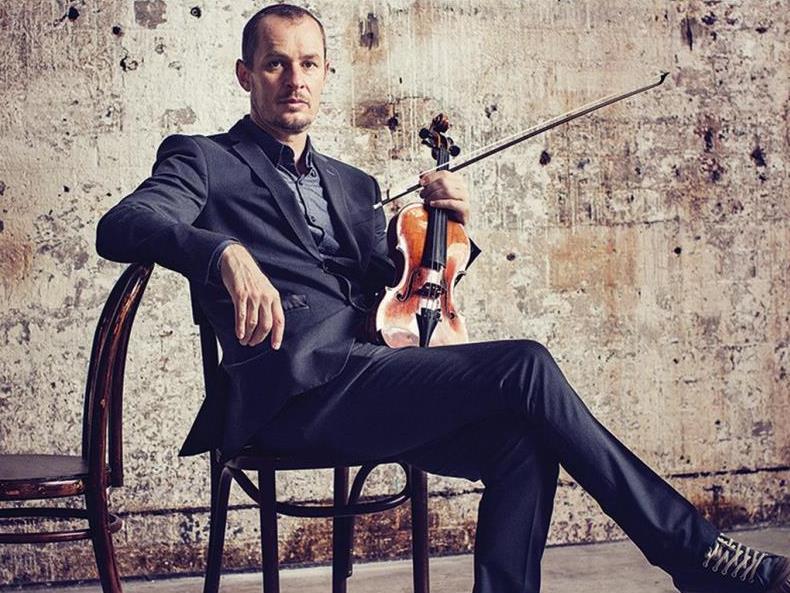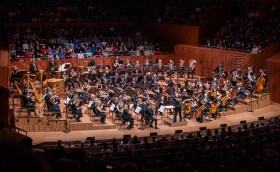Richard Tognetti, violin. Image via Australian Chamber Orchestra.
After the interval the audience was treated to a little spiel from artistic director and lead violinist Richard Tognetti, who began to enthuse, as he is wont to do, about the fantastic instruments that the Australian Chamber Orchestra has at their disposal. But there was one in particular that was new, namely that of the principal cello’s, Timo-Veikko Valve: a 1729 Guiseppe Guarneri filius Andreae cello. Tognetti explained that elements of the instrument were also crafted by his son, Gisueppe Guarneri del Gesu, who coincidentally was the man who made Tognetti’s own violin. Of note was a callout to Peter Weiss AO – in the audience for the performance – a man who we were told likes to ‘revel in his anonymity’, but who was responsible for the purchase of not only this cello, but the setting up of the ACO Instrument Fund that has acquired other instruments over the years. (Some members of the audience were less inclined towards his anonymity, eagerly pointing towards him during the many rounds of applause he received.)
And so we went off-program, with the principal cellist playing the prelude from Bach’s Cello Suite No.1 in G for a couple of minutes (If you’ve heard of any Bach cello piece, it is this one). There was a deep resonance and highly pleasant viscosity to the sound, and Valve had the audience spellbound. Interestingly, the Bach prelude was written within 10 years of the cello being made.
As for the rest of the concert, it was much of what one has come to expect from a baroque-focused afternoon with the ACO. Perhaps a tad hampered acoustic wise, considering the size of the ensemble, in the Concert Hall of the Sydney Opera House (although that never truly dampens the spirit or verve of the music on offer), the performances were nevertheless energetic at times and graceful at others. We began with Bach’s Orchestral Suite No.1 in C major, BWV1066, where the standouts were a particularly punctuated second gavotte, with the violins floating and hopping nimbly over the other instruments, as well as a sublime forlane (an unusual addition for the man we assume Bach was), before Vivaldi’s Concerto for Two Violins and Violoncello in D minor, RV565, gave us one of the rare moments of absolute breathlessness during Tognetti’s solo passage. Tognetti has an ability to enrapture with a mere two notes, and he had plenty more to work with here.
After the post-interval serenade from the new cello, it was more Vivaldi. First came the Cello Concerto in E minor, RV409, here performed by a man instead of the foundling girl it was written for. (The program notes that Rousseau who, like many others at the time, came to the Ospedale della Pieta convent and its chapel to admire the music that emanated from behind the modesty screen of its all-girl orchestra, was rather disappointed to find out how many of the supposed ‘angelic’ girls were ‘disfigured by smallpox’.) Timo-Veikko Valve proved to be a charismatic lead and smallpox-free, and no doubt did either Claudia, Santina, Teresa, Tonina, or Veneranda justice. (History and academia has apparently narrowed who the five active cellists of the Ospedale della Pieta the piece may have been written for were.)
Vivaldi’s Concerto for Four Violins in D major, RV549 followed, with Tognetti, much to the audience’s amusement, switching at one point with a violinist behind him, and taking up foot pedal duty at the same time. (Most of the orchestra used paper sheet music, but Tognetti and his comrade had a tablet on their music stand.) Last came Bach’s Orchestral Suite No.2 in B minor, BWV1067, with recordist Genevieve Lacey taking to the stage to provide a fluttering and galloping presence throughout, a clear virtuosity on display, especially during the polonaise. A small work of Handel’s was the encore, with a small section of what was described by Tognetti as ‘the new art of Baroque improvisation’, here comprised of him, the second violinist, and Lacey, when the time came to go off book.
Rating: 4 1/2 stars out of 5
RICHARD TOGNETTI & ACO SOLOISTS
Artists
Richard Tognetti Director & Violin
Genevieve Lacey Recorder
Timo-Veikko Valve Cello
Satu Vanska Violin
Ilya Isakovich Violin
Maja Savnik Violin
Program
BACH Orchestral Suite No.1 in C major, BWV1066
VIVALDI Concerto for Two Violins and Violoncello in D minor, RV565
VIVALDI Cello Concerto in E minor, RV409
VIVALDI Concerto for Four Violins in D major, RV549
BACH Orchestral Suite No.2 in B minor, BWV1067
Sydney Opera House Concert Hall
16 – 19 OCTOBER 2016





